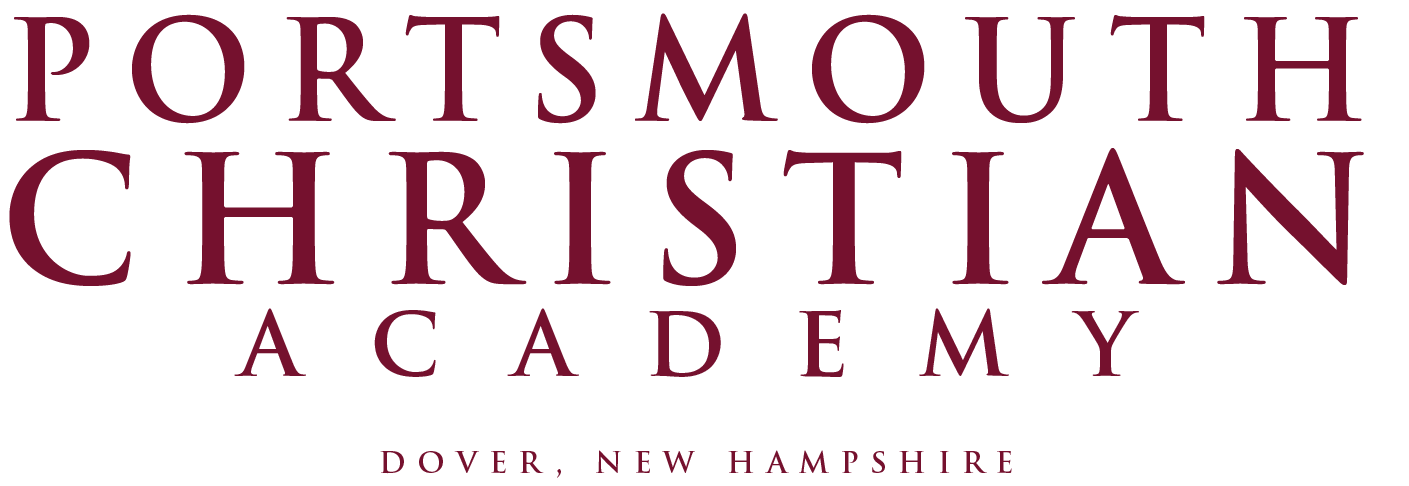2023 State of School Breakdown
As we turn the corner into the latter half of the 2022-2023 school year, we once again turned our attention to a broader look at our school’s people, program, and facilities through our annual State of School Address, delivered by Head of School, Mike Runey.
The State of School Address covers a variety of topics in roughly 30-minutes. From academic growth and program offerings to financial summaries and staff/faculty numbers, the State of School Address provides an all-encompassing look at how our school has performed over the last year.
This year’s State of School Address was delivered in-person in Troiano Hall, but you’ll find the basic breakdown of the Address, along with the full-length recording, below.
1. Gaining Momentum Through COVID
In the winter of 2022, our school was fighting through waves of the Omicron variant of COVID. Because our school remained open in the first year of COVID through the 2020-2021 school year, our school was continuing to build on academic, social, and spiritual growth in 2021-2022. This second-year growth included several areas:
- We learned to teach in new formats and manage a variety of new disruptions brought on by COVID.
- Our students were hitting their expected growth benchmarks at the conclusion of the 2021-2022 school year.
- Enrollment continued to soar, inviting over 150 new students to our classrooms while maintaining a nearly 90% retention rate among our existing student population.
2. Maintaining Healthy School Growth
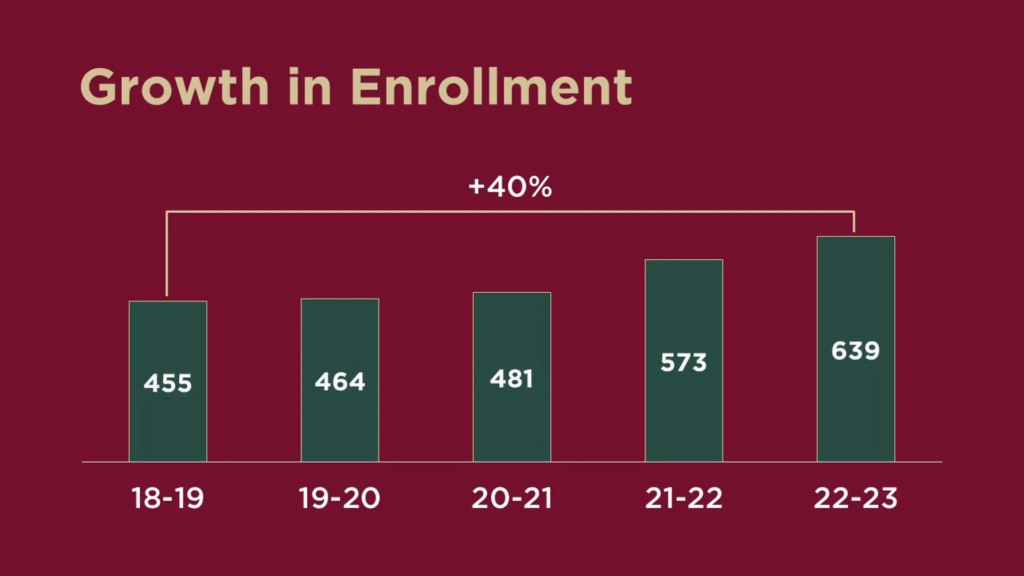
Enrollment Growth
At the start of the 2022-2023 school year, almost 640 students entered their classrooms for the first day of school. At the time of this article, that number has grown to just over 650 students. Traditionally, at this time of year, we’ve received around 40-60 applications for the upcoming school year. The past two years have seen between 160-170 applications at this point in the year.
We thank God for this increased interest in our school, and we thank YOU for sharing our mission with your friends and family members who could benefit from a PCA education as well.
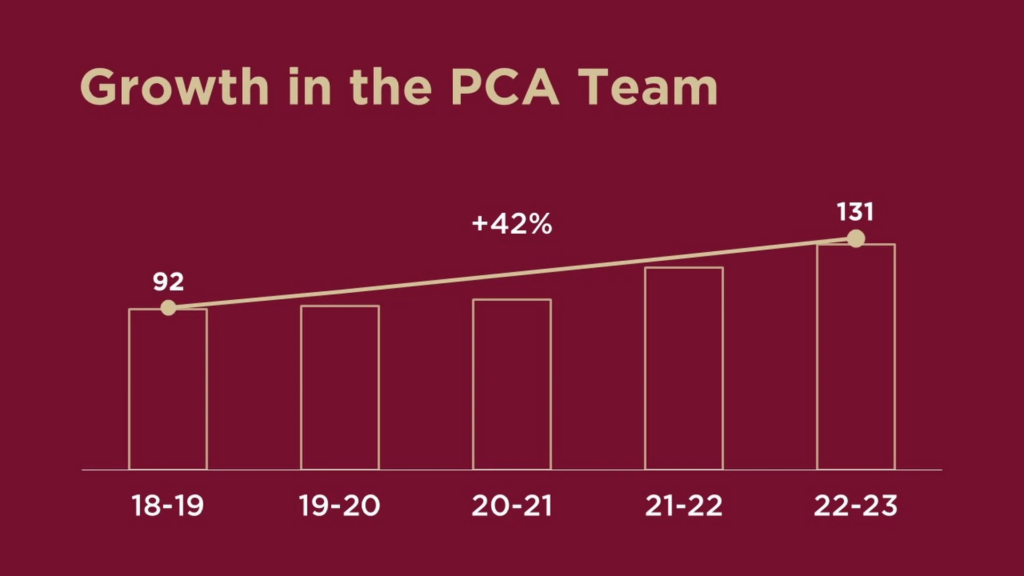
Staff/Faculty Growth
While enrollment growth continued to grow, we continued to add qualified teachers, staff and administrators who provide an excellent education to our students. The graph pictured above shows the year-over-year growth of our faculty and staff alongside the enrollment growth experienced in that same 5-year span.
Our goal is to continue to foster healthy growth with our team as we inspire our students to maximize their God-given potential.
As we’ve experienced increased enrollment growth, we’ve continued partner with families that believe in the same values and mission as we do. Regardless of your background, we are well-aligned at the parent-to-school level with all of our families, on values, character, and the faith we teach and build at PCA. This alignment with parents has been and remains essential.
3. Tuition Predictability and Proportionality
A common question asked about our enrollment growth has been how PCA can manage the financial responsibility of tuition amid changing demographics in our family population. The key to maintaining consistent tuition costs is linked to two words: Predictability and Proportionality.
We can assure you that each family invests proportionally in our school, and we thank you for that. We also want to be predictable in our tuition adjustments. This year’s tuition rate went up by just under 5%, in line with the rising costs of living. Where 70% of our expenses are related to salaries for our teachers and staff, this increase in the tuition rate will continue to help us keep our favorite teachers and staff members educating and mentoring your sons and daughters at PCA for next year.
As our economic landscape changes, we will continue to steward your tuition dollars responsibly. This means being strategic about adding programs and altering tuition rate changes. As we all feel the impact of inflation, know that we want PCA to remain an attainable investment for your children and grandchildren for years to come.
4. Academic Growth
Our focus as a school is to nurture your child’s growth over their achievement. What does that mean? It means we want your child to know their God-given potential and, over time, where that can take them.
Of course, each of our students attain varying levels of academic achievement, but we focus on growth that meets each of them where they are and challenges them appropriately.
The chart pictured here shows the growth levels measured during our NWEA testing for grades 3 through 10 in the winter of last year and the winter of this year. Notice the number 50. When schools reach 50, they have met their growth benchmark for the year. Last year, math lagged behind in terms of growth. After making the necessary adjustments to our math instruction, we’re happy to report that our math growth benchmarks were met this year.
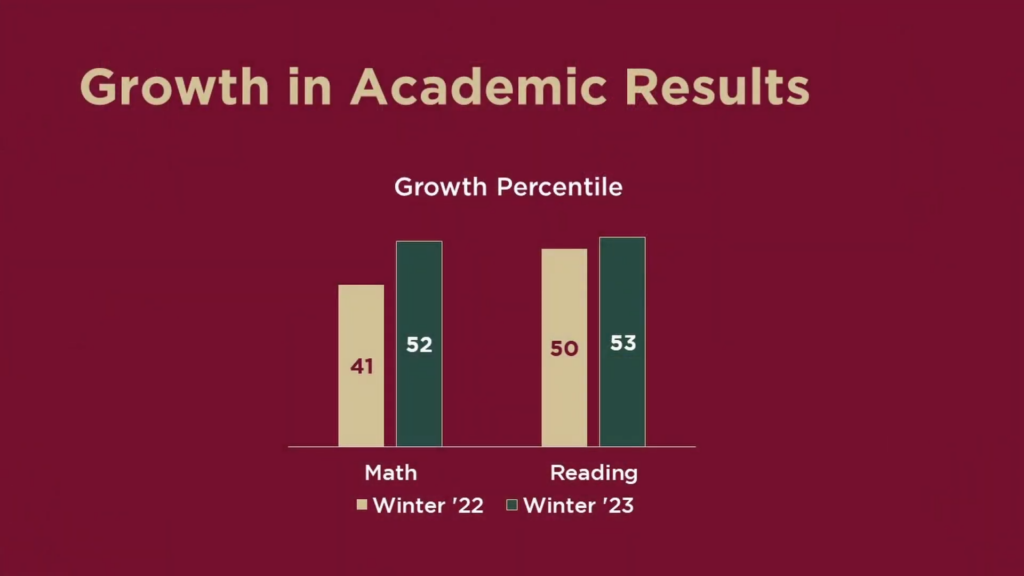
Another important term in education we use is “proficiency”: A student sufficiently capable in math or reading at current grade level. PCA’s growth approach leads to academic proficiency. That means that, in their grade-level, the student can accomplish what is academically expected of them at their age. Scoring in the 50th percentile, nationally, means that the student is meeting proficiency.
We’re going to look at our Middle School standardized test scores below. Middle School is a key point in a child’s educational maturation. Students’ scores reflect the growth they’ve experienced in our Lower School, and their academic preparedness to continue on to our Upper School.
The chart pictured here shows our Middle School proficiency rates from the winter of 2021 and the winter of 2022. Based on these scores, when compared to all Middle Schools in New Hampshire, PCA’s Middle School would rank in the top 5% of NH school districts based on student proficiency. The chart on the left shows that, as a whole, our students are being supported well.
The chart on the right shows how far our students are going when compared to that 50th percentile expectation. You can be confident that our students are performing above and beyond their expected benchmarks for their age.
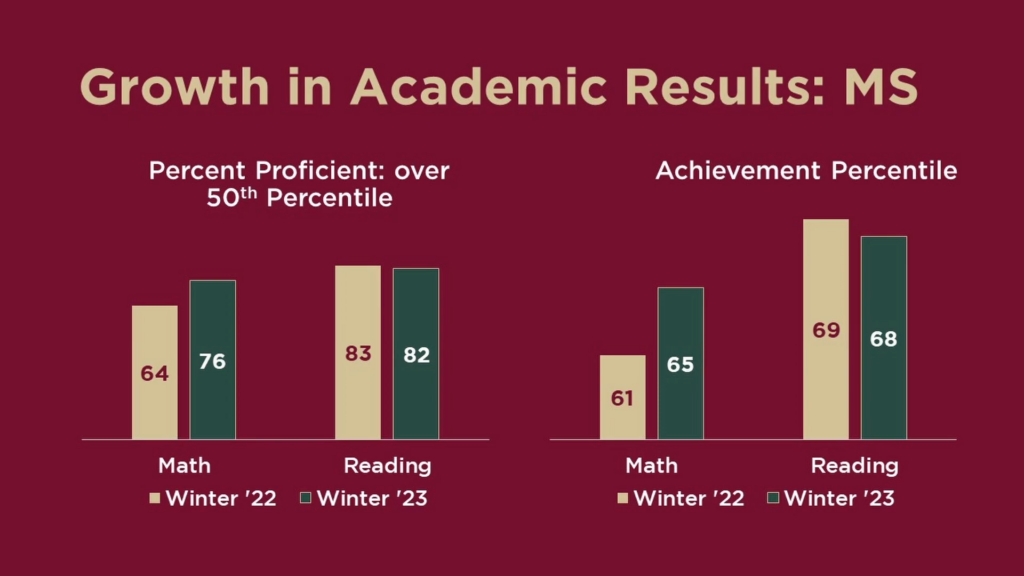
This last chart shows a number of local Middle Schools in New Hampshire compared to PCA, based on English Learning and Mathematic proficiency rates in their districts.
Only two schools, based on data provided by the State of New Hampshire, are on par with PCA in English Learning AND Mathematics, with some on par with one or the other.
Dover, Rochester, and other local districts are also lower than PCA in ELA and Math proficiency.
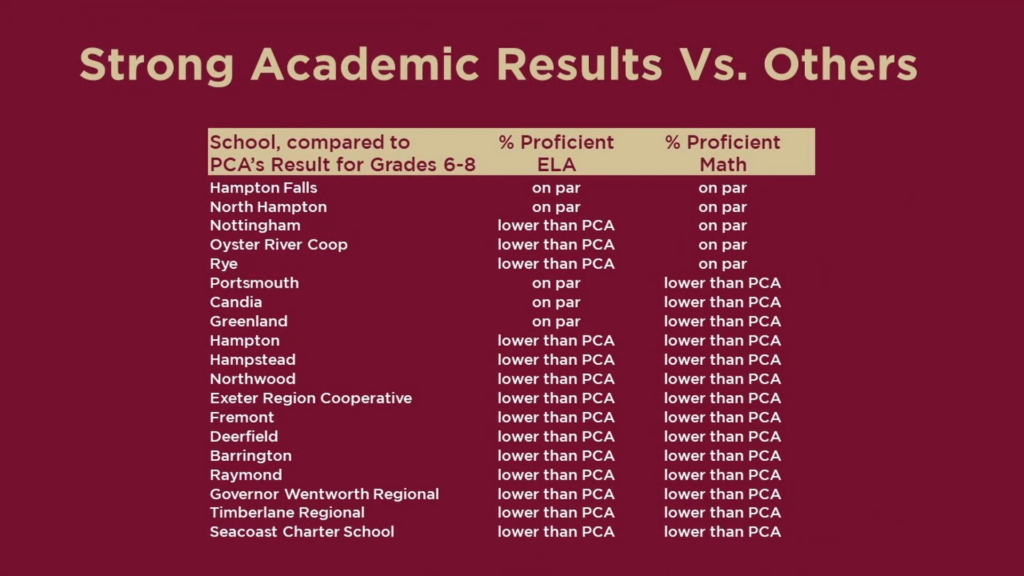
Program Highlights:
- In Preschool we rolled out TS Gold, a program for tracking and cataloging the growth of our preschool students academically and socially.
- Our focus on Math included installing MAP Accelerator, an online math education tool, on over 300 laptops for student use.
- We created pathways for our Middle School students to gain access to the math and Fine Arts offerings at the Upper School.
- We’re continuing to expand on leadership opportunities for our Middle and Upper School students through the Prefect Program and Small Group Leadership, with the goal of extending these leadership roles down to the Middle School.
- Eagle Sports Network (ESN) provides students with opportunities to learn about live-streaming using high-end A/V equipment.
- Food and Coat Drives, the Costa Rica Missions Trip, and the Missions Club all provide opportunities for students to serve others.
5. Impacts Associated with our Mission
1. Our challenging economic landscape could impact our families’ ability to invest in their child’s education and enrollment at PCA. Know that we’ll continue to aim to be predictable and proportional in our tuition-setting decisions.
2. Cultural norms in our world continue to beat against the values and principles that we teach at PCA. We will continue to stay faithful to our mission to maximize each child’s God-given potential, and continue to prayerfully navigate the changing tides of our culture.
3. Seacoast Classical Academy is a new charter school opening in the Exeter region, which could potentially provide additional opportunities for our families, and we support each family’s decision to do what’s best for their children. At the same time, we’re confident that our school will continue to be a learning community where Christian character and values are instilled through an excellent, Christ-centered education.
6. Looking to the Future
Short-Term Goals
First: Our school will continue to invest in our people and in our student culture. We continue to use feedback from our students and families to improve their experience at PCA. Moreover, we’ll continue to help build healthy relationships that foster spiritual, academic, and emotional growth.
Second: More enrollment growth means we’ll edge closer to our goal of three homeroom classes across each grade from Kindergarten through 8th Grade. Next year, we’ll be adding an additional 1st and 4th Grade homeroom. Waiting pools will continue to grow, first in Middle School and Preschool, then in several Elementary grades.
Third: To maintain long-term viability, we need to retain our excellent teachers. This means providing benefits and salaries that appropriately reward the hard-working educators who maximize your child’s God-given potential every day.
15-Year Strategic Plan
Phase 1: Continue to Respond to the Demands for an Excellent Christian Education in the Seacoast
Phase 2: Expand Our Tent to Create New Spaces and Places for Our Students to Grow, Learn and Thrive
Phase 3: Deepen the Impact on Our Students in Fine Arts, Athletics, and in Their Classrooms
Watch the Full Presentation Here
Click the following YouTube video to watch Mr. Runey’s State of the School Address in its entirety.
